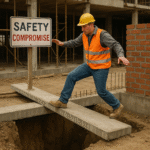|
Getting your Trinity Audio player ready...
|
The Australian construction industry builds our cities, but beneath the scaffolding lies a crumbling foundation: a mental health epidemic claiming lives at six times the rate of workplace fatalities. While hard hats and harnesses protect workers from physical falls, there’s no safety gear for the invisible falls—suicides driven by isolation, stigma, and unrelenting pressure.
This isn’t just a workplace issue; it’s a national tragedy.
This is the second-installation of our two-parts deep dive into the mental health crisis in construction, causes, initiatives, impact and the government intervention. While we have taken a considerable exploration into mental health crisis, suicide rates, causes, and the prevailing culture that enables this crisis, in this second part, we will be looking at initiatives and government interventions.
Government’s Role So Far: Spending vs. Outcomes

The Australian Government has demonstrated a commitment to mental health through various funding allocations. Under the National Mental Health and Suicide Prevention Agreement Bilateral Schedules, $144.2 million has been allocated to State and Territory Governments from 2024-25 to 2025-26.36 Additional funding includes $46 million over four years from 2024 for digital mental health services, as well as specific measures for First Nations psychology students, veterans’ mental health support, and the Volunteer Training in Suicide Recognition and Intervention program.36
State governments are also contributing significantly. New South Wales, for instance, is introducing a $344 million Workplace Mental Health package, which includes funding for over 50 new inspector positions specialising in psychosocial injury.37
Western Australia’s Construction Training Fund (CTF) acknowledges the elevated mental health risk for construction workers and provides funding for free mental health awareness, support, and suicide prevention training through providers like MATES in Construction WA Ltd.38 Victoria’s WorkSafe’s WorkWell Mental Health Improvement Fund supports initiatives like the “Positive Plans – Positive Futures Program” to enhance mental health outcomes in the civil construction industry.11 While there is clear investment, the critical question remains whether this spending is sufficiently targeted and achieving the desired impact on the ground within the construction sector.
An analysis of where these funds are directed reveals that while significant amounts are allocated nationally, much of this is broad-based and not specifically earmarked for the construction industry.36 While funding for digital services and general mental health support is beneficial, its direct impact on construction workers may be diluted without more specific industry targeting.
State-level initiatives, such as NSW’s investment in psychosocial inspectors 37 and WA’s CTF funding for MATES 38, represent positive examples of targeted approaches. However, a SafeWork NSW report indicated that while nearly half of businesses (PCBUs) had mental health systems in place, a small percentage were unsure of their provisions, and a significant 64% of workers had not accessed or even looked up available resources.2 This suggests a notable gap between the provision of resources and their actual utilisation, potentially due to persistent stigma or a lack of effective awareness campaigns. The challenge, therefore, is not solely the quantum of spending but its strategic deployment and effective reach within the unique and demanding construction environment.
The economic cost of inaction on mental health within the construction industry is staggering. The mental health challenges faced by the construction workforce are estimated to cost the Australian economy $1.57 billion.4 When considering broader cultural issues, including mental illness, long working hours, and a lack of diversity, the annual cost to the economy approaches $8 billion.11 This reinforces the compelling “commercial imperative” for decisive action.7 Investing in mental health is not merely a social good; it is a sound economic decision with a clear return on investment.
A critical observation is that while government direct funding for mental health exists, a more profound opportunity lies in leveraging government procurement. The Parliament of Australia’s report explicitly recommends that the Australian Government investigate how firms can demonstrate commitment to modern workplace standards, including wellbeing, working hours, and diversity, within their tender and delivery processes for government-funded infrastructure projects.4 The Construction Industry Culture Taskforce (CICT) strongly argues that the industry alone has been unable to reform its culture and that governments must mandate change through procurement processes.40 This means government spending can be far more impactful than just direct grants; it can compel widespread cultural and systemic change through contractual obligations for major projects. By embedding comprehensive mental health and wellbeing standards directly into procurement contracts, the government can utilize its significant purchasing power (e.g., $70 billion in Victoria 3) to shift the onus from voluntary participation to a mandatory condition of doing business, thereby driving industry-wide reform.
Furthermore, to ensure that government spending on mental health in construction is truly impactful, efficient, and evidence-based, there is a clear need for a national evaluation framework. As highlighted by MATES, consistent evaluation methodologies, guidance domains, and measures are necessary to assess the effectiveness and efficiency of programs.22
Without such a cohesive, standardised, and comparable evaluation system across all government and industry initiatives, it becomes difficult to ascertain which programs are most effective, where limited funds are best allocated, and how successful models can be scaled nationally. This leads to potential inefficiencies and a lack of clear accountability for public spending.
Implementing such a framework would allow for transparent data collection, cross-program comparisons, identification of best practices, and agile policy adjustments, ultimately leading to better resource allocation and a clearer understanding of the collective return on investment across various interventions.
Laying the Foundations for a Healthier Future: Solutions and the Way Forward
Addressing the silent crisis of mental health in Australian construction requires a multi-faceted and coordinated approach, encompassing policy reform, cultural transformation, and enhanced support systems.
Policy and Legislative Levers: More Than Just a Safety Vest
Current Work Health and Safety (WHS) laws already place a responsibility on employers to manage psychosocial hazards.2 However, there is a strong consensus that these laws need to be strengthened to “prescribe minimum standards of worker mental health, and mandate control measures to minimise and/or eliminate psychosocial risks”.42 New South Wales is at the forefront of this reform, having introduced flagship legislation aimed at strengthening psychological and physical WHS. These changes include new powers for SafeWork NSW and mandatory compliance with codes of practice, explicitly enshrining gender equality and the elimination of bullying and sexual harassment as core objectives.37
Moving from general duties to specific, mandated standards for psychosocial hazards will provide clearer guidance and stronger enforcement mechanisms, ensuring that mental health is treated with the same gravity as physical safety.
A significant lever for change lies in leveraging government procurement. The Parliament of Australia recommends that the Australian Government investigate how firms can demonstrate their commitment to modern workplace standards, including wellbeing, working hours, and diversity, within their tender and delivery processes for government-funded infrastructure projects.4
The Construction Industry Culture Taskforce (CICT) has developed a draft Culture Standard to facilitate this, proposing explicit requirements for wellbeing, “time for life” (work-life balance), and diversity.4 This approach transforms cultural reform into a condition for winning government contracts, utilising the government’s substantial purchasing power to drive systemic change across the industry. This is a crucial step in bridging the gap between policy intent and on-site reality, as it compels adherence rather than relying solely on voluntary adoption.
Furthermore, addressing unrealistic programming pressures in contracts is essential. Master Builders Australia has highlighted that time-based construction contracting, coupled with unreasonable and tight deadlines, significantly impacts mental health.4 Governments should actively explore options to mitigate these programming pressures within their procurement practices.4
The CICT’s draft Culture Standard proposes programming projects for 50 hours or less per week, with a maximum of 55 hours, and generally limiting work to Monday to Friday.40 This directly tackles one of the primary drivers of stress and burnout in the industry, moving towards a more sustainable and humane work model.
Shifting the Culture on Site: From “Tough Guy” to “Talking Mate”
The pervasive “macho” culture in construction, which often pressures workers to suppress emotions, must be challenged head-on.1 Creating environments where men feel safe to connect authentically and share openly is paramount.28 This involves actively promoting a culture where mental health and wellbeing are integrated into daily safety conversations.8 The aim is to cultivate psychological safety, making it genuinely “OK to not be OK” within the workplace.8 This redefines the concept of strength, moving it from stoicism to the courage to seek and offer help.
Leadership by example and accountability from the top are critical. Leaders and supervisors play a pivotal role in modelling acceptable behaviour and fostering a positive work environment.8
Upskilling managers and supervisors in mental health awareness and equipping them with the skills to identify and support struggling workers is essential.10 This training results in leaders who are more confident in initiating mental health conversations and effectively managing work-related risks.10 Change must be driven from the top down, with clear expectations and comprehensive training for all in leadership positions.
Given the high rates of bullying and harassment 1, robust anti-bullying and harassment policies are non-negotiable.1 Employers must take all reasonably practicable steps to resolve bullying incidents before they escalate into more serious psychosocial hazards.6 New South Wales’ new legislation explicitly targets these issues, providing stronger legal frameworks for prevention and redress.37 A psychologically safe environment is the foundational prerequisite for mental wellbeing on any site.
Promoting genuine work-life balance and flexible arrangements is also crucial to address the pervasive home-work conflict.7 This includes implementing flexible work arrangements such as job sharing, part-time work, and remote work where feasible.1 This acknowledges the realities of modern life and the fundamental need for workers to balance professional demands with their personal and family responsibilities, ultimately contributing to improved mental health outcomes.
The “mateship” culture, while a strong bond, can paradoxically enforce silence and stoicism, acting as a barrier to help-seeking.1 However, peer support models that build upon existing relationships and experiences have proven to be highly successful.25
The success of programs like MATES is partly attributed to building “passion and camaraderie” and leveraging “strong group identity” and “mateship” to encourage help-offering.27 The strength of this bond can be transformed from a lock to a key by empowering workers to actively look out for each other, normalising help-offering within trusted peer networks, and reframing help-seeking as a sign of strength for both the team and the individual.
Strengthening Peer Support and Accessible Resources
The demonstrated success of programs like MATES and Bluehats underscores the critical importance of worker-to-worker peer approaches.25 Research consistently indicates that supervisors are often the least trusted resources for mental health concerns, highlighting the unique value of peer support networks.26
These programs should be expanded across the industry, and their effectiveness must be continually evaluated through consistent methodologies to ensure optimal impact and resource allocation.22 Peer support leverages the unique bonds within the industry, providing a trusted, accessible pathway to help that resonates deeply with the workforce.
Many workers currently lack access to adequate mental health support 1, and there is a clear demand for more accessible information and resources.2 Employers should actively consider providing on-site mental health services, including counselling and crisis support, to make it easier for workers to access the help they need without leaving the site.1
Digital tools and apps, such as Black Dog’s HeadGear, offer accessible and anonymous support, appealing to the preference for self-reliance prevalent in the industry.10
Furthermore, culturally safe support is essential for First Nations workers and those from linguistically diverse backgrounds, ensuring that services are relevant and welcoming to all.18 Accessibility, anonymity, and cultural relevance are key to overcoming existing barriers to help-seeking.
Education, Training, and Resilience Building
Upskilling managers and supervisors to effectively identify and support struggling workers is paramount. Supervisors need to be equipped with the knowledge and confidence to initiate early conversations about mental health and understand when and how to escalate for professional help.8
Training for managers can lead to them being more confident in initiating mental health conversations and proactively managing work-related psychosocial risks.10 Managers are on the front lines and require the necessary skills to recognise signs of distress and respond appropriately, thus fostering a more supportive work environment.
Equipping all workers with practical coping strategies and resilience tools through ongoing education and training around mental health is vital.1 This includes educating workers on healthy coping mechanisms, how to build psychological resilience, and how to confidently ask for help when needed.9
Encouraging positive coping strategies, such as regular exercise and engaging in enjoyable activities, is also important for overall well-being.8 While systemic changes are paramount, empowering individuals with tools for self-care and help-seeking remains a critical component of a comprehensive mental health strategy.
Finally, mental health cannot be treated as an optional add-on or a separate “HR issue”; it must be as integral to site operations, planning, and daily routines as physical safety. The alarming statistic that the industry is six to eight times more likely to lose a worker to suicide than an accident 1 highlights a stark contrast with highly developed physical safety protocols.
Recommendations to integrate mental health into workplace safety protocols 9 and include mental health in safety conversations 8 are crucial. The CICT’s proposal for a “cultural standard implemented via the procurement process… programmed within the project schedule to support mental health and wellness” rather than “one-off courses or training potentially rolled out on an ad hoc basis” 4 suggests that mental health needs to transition from a reactive, isolated concern to a proactive, embedded element of core operations.
This means embedding psychosocial risk assessments into project planning from the outset, incorporating mental health discussions into daily toolbox talks, and ensuring that mental health is a continuous, proactive effort within the overall safety management system, rather than merely a reactive response to crises.
Conclusion: A Fair Go for Every Tradie
The facts are laid bare: the Australian construction industry is grappling with a severe mental health crisis, characterised by tragically high suicide rates and widespread psychological distress. This deeply affects individuals and their families, and it represents a significant economic drain, costing billions annually. The human cost, however, remains immeasurable.
The good news is that this journey does not begin from scratch. Industry-led initiatives, such as MATES in Construction, have unequivocally proven their worth, demonstrating that targeted, peer-based approaches can save lives and deliver substantial returns on investment. Governments, at both federal and state levels, are beginning to step up, introducing legislative changes and allocating crucial funding. However, piecemeal efforts will not suffice. A sustained, coordinated push, driven by a shared understanding of the problem’s systemic nature, is essential.
This means the government must leverage its immense procurement power to mandate cultural shifts, ensuring that mental health and well-being are non-negotiable components of every major project. It means industry leaders must actively dismantle the entrenched “tough guy” culture, fostering environments where speaking up is recognised as a sign of strength, not weakness. And it means every single one of us, from the CEO to the newest apprentice, must commit to looking out for our mates, having those tough conversations, and knowing precisely where to turn for help.
Imagine a construction site where mental health is discussed as openly and routinely as physical safety. Where a mate asking “R U OK?” is as common and accepted as a safety check. Where the inherent pressures of the job do not break a person, but rather, a robust and compassionate support system lifts them up.
This is not a pipe dream; it is an achievable future for our industry. By working together, with a clear strategy and an unwavering commitment to action, we can ensure that every tradie in Australia receives a fair go at a healthy, fulfilling life, both on and off the tools.
Let us build a stronger, healthier industry, one conversation, one policy, one mate at a time.
_________
Works cited as sources
Does Australia Have A Mental Health Crisis In Construction? – CHAS, accessed May 27, 2025, https://www.chas.net.au/blog/does-australia-have-mental-health-crisis-in-construction/
Findings Report: Mental Health in Construction 2022 | SafeWork NSW, accessed May 27, 2025, https://www.safework.nsw.gov.au/about-us/evaluation/findings-report-mental-health-in-construction-2022
Mental health in the construction industry – Productivity Commission, accessed May 27, 2025, https://www.pc.gov.au/__data/assets/pdf_file/0009/251001/sub827-mental-health.pdf
8. Addressing cultural reform in the construction industry – Parliament of Australia, accessed May 27, 2025, https://www.aph.gov.au/Parliamentary_Business/Committees/House/Former_Committees/ITC/Gov-fundedInfrastructure/Report/section?id=committees/reportrep/024903/79250
Stats & Facts – Suicide Prevention Australia, accessed May 27, 2025, https://www.suicidepreventionaust.org/news/statsandfacts
Australian case highlights need to manage mental health risks on construction sites, accessed May 27, 2025, https://www.pinsentmasons.com/out-law/analysis/australian-need-manage-mental-health-risk-construction-sites
Construction Workforce’s Mental Health: Research and Policy …, accessed May 27, 2025, https://www.mdpi.com/2075-5309/13/2/335
Mental health in Construction – Fact Sheet – SafeWork NSW, accessed May 27, 2025, https://www.safework.nsw.gov.au/__data/assets/pdf_file/0020/1037342/mental-health-in-construction-fact-sheet.pdf
Concerning new findings on mental health in WA’s construction industry – The University of Western Australia, accessed May 27, 2025, https://www.uwa.edu.au/news/article/2024/december/concerning-new-findings-on-mental-health-in-was-construction-industry
Black Dog Institute turns to construction workers to address mental …, accessed May 27, 2025, https://www.blackdoginstitute.org.au/news/black-dog-institute-turns-to-construction-workers-to-address-mental-health-support/
The state of mental health in the infrastructure construction industry – CEDA, accessed May 27, 2025, https://www.ceda.com.au/newsandresources/opinion/corporate-social-responsibility-i-social-compact/the-state-of-mental-health-in-the-infrastructure-c
tistraining.com, accessed May 27, 2025, https://tistraining.com/psychological-distress-fifo-workers-have-higher-levels/#:~:text=Large%20Australian%20studies%20have%20also,it%20is%20for%20older%20workers.
FIFO and Mental Health: Signs & When to Get Help | Altius Group, accessed May 27, 2025, https://altius.au/news-and-research/fifo-mental-health-spotting-the-signs-and-getting-help
Fly-in fly-out – Wikipedia, accessed May 27, 2025, https://en.wikipedia.org/wiki/Fly-in_fly-out
(PDF) Suicide trends among Australian construction workers during years 2001–2019, accessed May 27, 2025, https://www.researchgate.net/publication/365717432_Suicide_trends_among_Australian_construction_workers_during_years_2001-2019
Mental Health Challenges the Australian Construction Industry., accessed May 27, 2025, https://mentalconstruct.com.au/f/mental-health-challenges-the-australian-construction-industry
Mental Health In Construction Statistics – Foremind, accessed May 27, 2025, https://foremind.com.au/mental-health-statistics-in-construction/
The mental health of migrant workers in the Australian construction sector: a literature review, accessed May 27, 2025, https://sciexplor.com/articles/2811-0730-0201-6
MATES in Construction (AUST) Limited – Medicare Mental Health, accessed May 27, 2025, https://www.medicarementalhealth.gov.au/provider/mates-in-construction-aust-limited-16585
Mates in Construction – Injury Matters, accessed May 27, 2025, https://www.injurymatters.org.au/resources/edirectory/organisations/mates-in-construction/
Suicide Prevention Support in the Construction Industry | Medicare Mental Health, accessed May 27, 2025, https://www.medicarementalhealth.gov.au/service/suicide-prevention-support-in-the-construction-industry-17490
MATES in Construction – Mental Health and Suicide Prevention Agreement Review – Productivity Commission, accessed May 27, 2025, https://www.pc.gov.au/__data/assets/pdf_file/0011/391871/sub033-mental-health-review.pdf
MATES Research – Mates in Construction, accessed May 27, 2025, https://mates.org.au/construction/research?researchYear=2024
Research – MATES in Construction, accessed May 27, 2025, https://mates.org.au/research
Peer Support Programs to Promote Mental Health Among Construction Workers – CPWR, accessed May 27, 2025, https://www.cpwr.com/wp-content/uploads/SS2025-Peer_Support_Mental_Health_Construction_Workers.pdf
Effectiveness of the Australian MATES in Construction Suicide Prevention Program: a systematic review – PMC – PubMed Central, accessed May 27, 2025, https://pmc.ncbi.nlm.nih.gov/articles/PMC10468011/
role of social identity in a suicide prevention programme for construction workers in Australia | Health Promotion International | Oxford Academic, accessed May 27, 2025, https://academic.oup.com/heapro/article/39/5/daae140/7831183
More Than Safety Gear: 6 Initiatives Supporting Mental Health in Construction, accessed May 27, 2025, https://www.jvrecruitment.com.au/more-than-safety-gear-6-initiatives-supporting-mental-health-in-construction
Bluehats Hub – Incolink, accessed May 27, 2025, https://incolink.org.au/bluehats-hub
Bluehats supporting the mental health of our industry – Incolink, accessed May 27, 2025, https://incolink.org.au/news/bluehats-supporting-the-mental-health-of-our-industry
Effectiveness of the Australian MATES in Construction Suicide Prevention Program: a systematic review – PubMed, accessed May 27, 2025, https://pubmed.ncbi.nlm.nih.gov/37647522/
Suicide trends among Australian construction workers during years 2001–2019, accessed May 27, 2025, https://lifeinmind.org.au/research/research-updates/suicide-trends-among-australian-construction-workers-during-years-2001-2019
Work and mental health – Beyond Blue, accessed May 27, 2025, https://www.beyondblue.org.au/mental-health/work
Black Dog Institute – Healthdirect, accessed May 27, 2025, https://www.healthdirect.gov.au/partners/black-dog-institute
Promoting Mental Health in Australia’s Construction Industry – Sydney Build Expo, accessed May 27, 2025, https://www.sydneybuildexpo.com/mental-health-in-resource-library/promoting-mental-health-australias-construction-industry
2025-26 Federal Budget Summary – Mental Health Australia |, accessed May 27, 2025, https://mhaustralia.org/sites/default/files/docs/mha_2025-26_federal_budget_summary_.pdf
Minns Labor Government introduces flagship legislation to prevent …, accessed May 27, 2025, https://www.nsw.gov.au/ministerial-releases/minns-labor-government-introduces-flagship-legislation-to-prevent-psychological-and-physical-workplace-injuries
WA Construction Industry Mental Health Support | CTF, accessed May 27, 2025, https://ctf.wa.gov.au/funding/mental-health-awareness-and-support
POSITIVE PLANS, POSITIVE FUTURES PROJECT – WORKING TO IMPROVE MENTAL HEALTH IN CONSTRUCTION – Civil Contractors Federation Victoria, accessed May 27, 2025, https://www.ccfvic.com.au/wp-content/uploads/2020/10/WorkWell-Editorial-Earthmoving-Equipment-Magazine-AugSep2020_Pages-122-123.pdf
8. Addressing cultural reform in the construction industry …, accessed May 27, 2025, https://www.aph.gov.au/Parliamentary_Business/Committees/House/Former_Committees/ITC/Gov-fundedInfrastructure/Report/section?id=committees%2Freportrep%2F024903%2F79250
Mental Health Education, Training and Resources | Office of the Federal Safety Commissioner, accessed May 27, 2025, https://www.fsc.gov.au/mental-health-education-training-and-resources
Full article: What’s it going to take? Lessons learned from COVID-19 and worker mental health in the Australian construction industry, accessed May 27, 2025, https://www.tandfonline.com/doi/full/10.1080/01446193.2023.2205158







